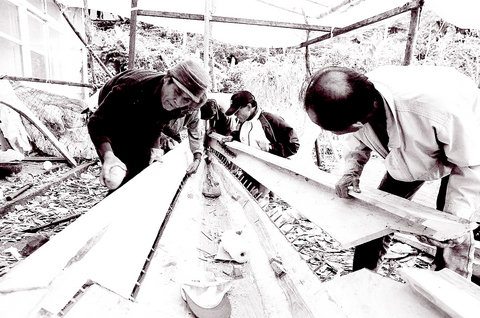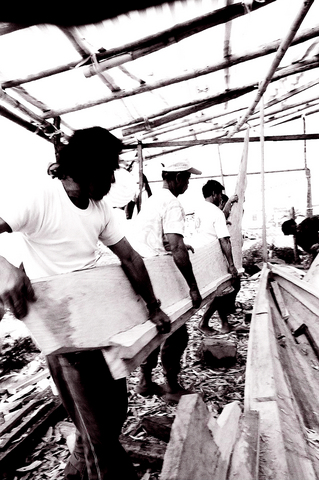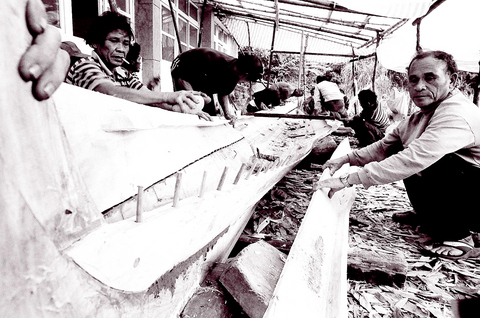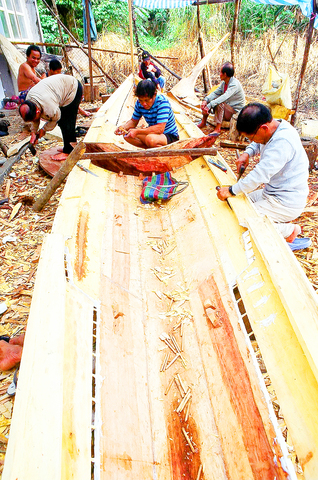Maraos (瑪拉歐斯) grew up listening to stories of a great seafaring nation of islands that shared the same language and culture as his own — the Tao (達悟族) — who lived off a diet of flying fish, crustaceans, taro and millet. But centuries ago, the tale goes, a marriage dispute between the islands broke the nation apart.
"When I was young I heard a lot about this story," he says. "And I sometimes think [about it] when I'm on the water."
The Lanyu (蘭嶼 — also called Orchid Island) native, who now lives and works in Taipei, spends many of his weekends and holidays rowing a small boat in Wulai and Hualien preparing for a grueling ocean voyage around Taiwan. The journey will see him and other members of the Tao tribe — known also as the Yami (雅美族) — set off from Lanyu, off the south-eastern coast of Taiwan and make a two-month journey that will bring them first to Taidung and then up the east coast to Taipei.

PHOTOS: COURTESY OF WAN PEI-CHYI
The journey from Taipei down the Taiwan Straight commences in September and ends in early 2008. The rowers will travel a total of 1,145km in 20 stages, visiting numerous destinations throughout the island.
The project, known as Keep Rowing (繼續划船), is an effort by the Tao people to relive an ancient voyage Maraos says dates back centuries, if not millennia, by constructing and rowing a traditional boat — called ipanga na in the Tao language — around Taiwan. But circumnavigating Taiwan is only a preface to a second more personal journey to the Batanes, a group of islands 100km south of Lanyu that formed part of the legendary nation spoken of by Maraos' ancestors.
Organized by Taiwan Indigenous TV, with support from the Council for Indigenous Peoples and Taidung's Science and Technology Museum, the crew hopes that by visiting towns and cities around the island, the Tao can educate the people of Taiwan about their seafaring culture and raise environmental awareness.

"Though no living member of the Tao tribe has ever attempted this journey, legend tells us that our ancestors made the trip," said Wan Pei-chi (萬蓓琪), who is helping to promote the event. She added that 10 members of the Tao tribe will make the maiden voyage from Lanyu to Taidung, "but after that, anyone is welcome to participate."
The organizers chose the months of June and July because it is a time when the Black Stream (黑潮) — also known as the Kurosiro Current — that flows northward along the eastern coast of Taiwan is at its best for the journey.
"In June the current is not very strong," said Maraos. He added, "we will use the moon and current to maneuver our boat and [gauge our] position. This is from our traditional ocean culture and knowledge," he said.

Though the crew will rely on ancient methods of navigation, two boats will follow them for safety and to document their journey.
"As no one has attempted this journey in recent memory, the old generation doesn't want the young generation to meet any danger," said Maraos.
That a younger generation of Tao people is attempting the journey shows the level of respect they have for traditional customs and the fears they have of losing their old ways of navigation and boat building — traditions that may come to an end as the older generation passes away.

"The younger generation is becoming concerned that the old ways will be lost," said Wan.
Teaming up with Taidung's Science and Technology Museum enabled Tao boat-building craftsmen to re-create one of the boats on display.
"A boat like this hasn't been built for over 20 years," Wan said.

Typically holding four or six people, the boat crafted for the journey can hold up to 18 people — though Maraos says only 10 to 13 voyagers will be in the boat at any one time.
Crafting the boat was a long and difficult process that took over a year. It began by chopping down large trees located deep in the island's mountains. The builders then used chainsaws, the only modern implement employed, to chop the trees into long segments that were removed from the jungle and assembled close to the sea.
"The hull is crafted from softwood and the keel is made from the pomatia pinnala tree — a hardwood found on the island," said Yang Cheng-hsien (楊政賢) a researcher at National Taiwan University.
Maraos shows how Tao boat builders take measurements by using his fingers, hands and arms. Seventeen separate pieces are fastened together with glue and wooden spikes.
"We use no measuring tools or [metal] nails," he said.
Once the boat is finished, symbols are carved and painted onto the side designating the origin of the family who crafted it. "This is a true friend of the earth," he says, motioning to a picture of the boat.
The beginning of the trip coincides with the end of Lanyu's fishing season. Flying fish are revered by the Tao and form an important staple food. The Tao catch only enough fish to feed their people and have no traditional system of commerce, instead sharing the haul among the island's families.
The Tao have witnessed depleted stocks of flying fish over the past years due to over fishing and pollution.
"The Han people do not know how to respect our environment or our flying fish because they want a lot of fish," Maraos said.
If the journey around Taiwan raises cultural and environmental awareness, the trip to the Batanes is meant to raise awareness of a different kind. The Ivatan people who live there are ethnically the same as the Tao.
"These are our people," said Maraos. "We speak the same language and we share the same culture," he said.
Indeed, recent archaeological evidence by anthropologists in Taiwan, Australia and the Philippines shows that intermittent contact between Taiwan and the Batanes has occurred for over 4,000 years, dating back to Neolithic times. Oceanographic information indicates a countercurrent flowing from north to south immediately to the east of the Kuroshio Current, which probably explains the cultural and linguistic similarities between the two island groups.
In addition to the dispute between the two islands, Dutch and Spanish colonization of the Philippines and Chinese colonization of Taiwan ensured a lasting separation of the Tao and Ivatan.
By using his tribe's boats as a means of reconnecting with the people of the Batanes, Maraos is fulfilling a lifelong dream.
"This is my ... and Lanyu people's dreams. Building a big boat [to travel] from one island to another island," he said.

One of the biggest sore spots in Taiwan’s historical friendship with the US came in 1979 when US president Jimmy Carter broke off formal diplomatic relations with Taiwan’s Republic of China (ROC) government so that the US could establish relations with the People’s Republic of China (PRC). Taiwan’s derecognition came purely at China’s insistence, and the US took the deal. Retired American diplomat John Tkacik, who for almost decade surrounding that schism, from 1974 to 1982, worked in embassies in Taipei and Beijing and at the Taiwan Desk in Washington DC, recently argued in the Taipei Times that “President Carter’s derecognition

This year will go down in the history books. Taiwan faces enormous turmoil and uncertainty in the coming months. Which political parties are in a good position to handle big changes? All of the main parties are beset with challenges. Taking stock, this column examined the Taiwan People’s Party (TPP) (“Huang Kuo-chang’s choking the life out of the TPP,” May 28, page 12), the Democratic Progressive Party (DPP) (“Challenges amid choppy waters for the DPP,” June 14, page 12) and the Chinese Nationalist Party (KMT) (“KMT struggles to seize opportunities as ‘interesting times’ loom,” June 20, page 11). Times like these can

JUNE 30 to JULY 6 After being routed by the Japanese in the bloody battle of Baguashan (八卦山), Hsu Hsiang (徐驤) and a handful of surviving Hakka fighters sped toward Tainan. There, he would meet with Liu Yung-fu (劉永福), leader of the Black Flag Army who had assumed control of the resisting Republic of Formosa after its president and vice-president fled to China. Hsu, who had been fighting non-stop for over two months from Taoyuan to Changhua, was reportedly injured and exhausted. As the story goes, Liu advised that Hsu take shelter in China to recover and regroup, but Hsu steadfastly

You can tell a lot about a generation from the contents of their cool box: nowadays the barbecue ice bucket is likely to be filled with hard seltzers, non-alcoholic beers and fluorescent BuzzBallz — a particular favorite among Gen Z. Two decades ago, it was WKD, Bacardi Breezers and the odd Smirnoff Ice bobbing in a puddle of melted ice. And while nostalgia may have brought back some alcopops, the new wave of ready-to-drink (RTD) options look and taste noticeably different. It is not just the drinks that have changed, but drinking habits too, driven in part by more health-conscious consumers and